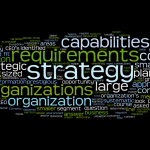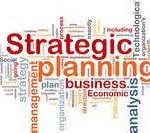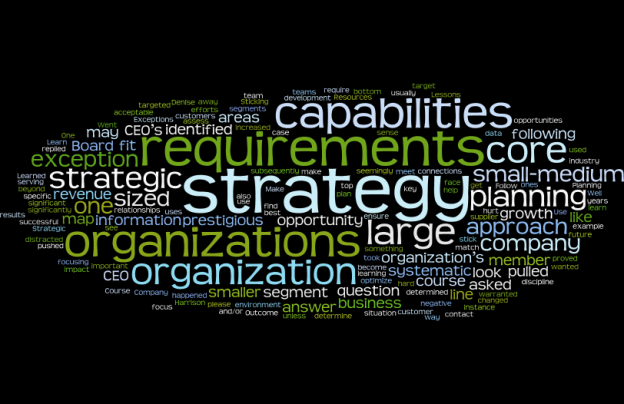Author: Denise Harrison
“Strategic planning is messy” declared one CEO as a team member expressed a desire for a more linear approach, frustrated because he couldn’t see the end game. The CEO went on to say, “It’s okay that it is messy – we have to consider many alternatives and new information before we funnel down to the few things that we will select to do.” I find that when people embark on strategic planning, they want the process to be simple and linear; some want the answers to be obvious. So why is strategic planning messy?
Contemplating the external factors that impact your business – gathering information and creating a shared base of knowledge
When your team starts its strategic planning journey, it should first identify the topics worthy of research, before the team can make informed decision about the course and direction of the company. This research allows the team to make decisions based on facts and information, rather than on opinions and top-of-mind thinking. Typically, information will be collected about:
- Core business segments – our customers
- Competitors
- Technology
- Suppliers
- Economic and Industry Trends
- Regulations
- Human resource availability
- Potential new opportunities
Once the information has been gathered in a consistent format, it is shared with the team, so now each team member has a foundation for decision making.
Still, even with this shared base of knowledge, people interpret information differently and give different weights to the information. But with this base, your team needs to decide:
- Which of our core businesses should get the most emphasis?
- What opportunities should we pursue?
- How can we enhance the way we differentiate ourselves in the market?
- What do we need to develop internally to get where we want to go?
There are many steps to take to sort out these questions – you often drill down, make selections and then cycle back. During a recent planning session, we started out reviewing research on 14 opportunities to significantly enhance the company’s growth. Next, we developed a profile of an industry leader, looking out five to ten years. Then we screened the opportunities, using the research provided and our vision of the industry leader as a backdrop as we went through the screening process. We easily selected the top three opportunities – by a landslide! Next, we discussed the three opportunities and it quickly became obvious that one was not as good as the others. What was next? Just drill down on the two? No, it was not that easy. As we discussed the two, we found that we had two ways to pursue each one and thus, we were back up to four. We then looked at the benefits and costs of each choice and we were able to come back to two. Now each of the options was well developed and there was consensus that these were the two that needed the team’s effort during the next year.
Was the process pretty? No, along the way, many voiced frustrations during the journey, sensing that we would never get to a conclusion. But in the end, all the team members embraced the process and said they wouldn’t have guessed the team would have made the progress that it did coming to a consensus and a clear direction as quickly as we did. While the process was messy, when it came down to selecting top picks, the list narrowed down quickly. As the team went through the final discussions, it was able to dig deep and get to the heart of the issue. Good information enabled the team to sort through what was important and to have a deep dive discussion on the opportunities that rose to the top. When the team left the meeting, everyone was firmly behind the topics selected and ready to work on developing action plans to achieve success.
But we didn’t use all the information gathered!
Yes, this is often the case; but how do you know what is important when you start? After researching certain topics, you may conclude that the topic will not impact the strategy for this round of strategic planning. But, you don’t know this when you start and sometimes a topic may not be relevant, but it will spur discussion on another topic that is important, or it may be important to future strategic planning sessions, so starting people thinking about it see can have some value.
The hardest part of strategic planning is what you say “no” to
As mentioned above, during strategic planning, you will consider a great deal of information and many options to develop the strategic planning that best positions your company for success. During the life of your company, you will focus in different areas to achieve success. For instance, take the case where you are having difficulty meeting your delivery schedules and/or have issues with product quality that are causing your company to lose market share. While it may be fun to think about product innovation, if you can’t get the product out the door with the customer-required quality, all the innovation will go unnoticed or noticed and copied by your competition. You may have to say “no” to some good ideas until you get to a place where your company is truly able to capitalize on its innovation. This doesn’t mean you stop innovating, it is simply a question of emphasis. Sometimes you need to build the foundation for growth to occur. Unfortunately, this sometimes makes strategic planning seem messy, as people don’t see things happening that are important to them. Making the hard decisions as to what must come first can cause a great deal of discussion and healthy disagreement. It is through these conversations that the course and direction are selected, and the key strategic initiatives selected – all selected to further position the corporation for future success. Is fixing production fun? Enhancing quality sexy? But often if these aspects are not fixed, we may not have the platform to launch our innovative products and services.
Messy, but thorough
So, no, strategic planning is not necessarily a linear process. It allows for ideas to come in from multiple sources. It generates discussions about multiple options, often cycling around and discussing them again. Then, the actual strategy summarizes what the team has discussed, the course and direction for the next 3-5 years for your core business segments, the new opportunities you want to pursue and what you need to develop internally to get where you want to go. Then you take it down to tactics – what turns strategy into action: what are the 6-10 key strategic initiatives the team would like to accomplish in order to move the strategy forward for the next 12 to 18 months.
If you have questions about strategic planning, please contact: Denise Harrison, harrison@thestratplan.com
 Different Scenarios Enable Successful Strategic Planning
Different Scenarios Enable Successful Strategic Planning


